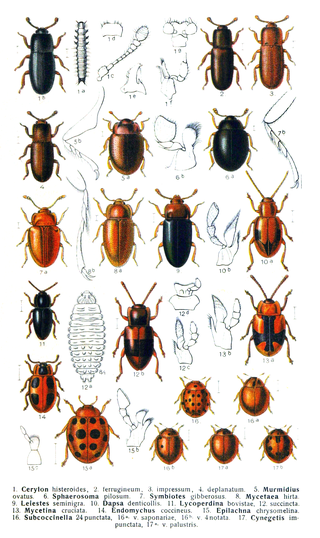This article classifies the subgroups of the order Coleoptera (beetles) down to the level of families, following the system in "Family-group names in Coleoptera (Insecta)", Bouchard, et al. (2011), [1] with corrections and additions from 2020, [2] with common names from bugguide.net. [3]
- Order Coleoptera
- Suborder †Protocoleoptera
- Superfamily †Tshekardocoleoidea Rohdendorf, 1944
- Family †Tshekardocoleidae Rohdendorf, 1944
- Family †Labradorocoleidae Ponomarenko, 1969
- Family †Oborocoleidae Kukalová, 1969
- Superfamily †Permocupedoidea Martynov, 1933
- Family †Permocupedidae Martynov, 1933
- Family †Taldycupedidae Rohdendorf, 1961
- Superfamily †Permosynoidea Tillyard, 1924
- Family †Ademosynidae Ponomarenko, 1968
- Family †Permosynidae Tillyard, 1924
- Superfamily †Tshekardocoleoidea Rohdendorf, 1944
- Suborder Archostemata
- Superfamily Cupedoidea Laporte, 1836
- Family Crowsoniellidae Iablokoff-Khnzorian, 1983
- Family Cupedidae Laporte, 1836
- Family Micromalthidae Barber, 1913

Micromalthus debilis - Family Ommatidae Sharp and Muir, 1912
- Family Jurodidae Ponomarenko, 1985
- Family †Triadocupedidae Ponomarenko, 1966
- Family †Magnocoleidae Hong, 1998
- Family †Obrieniidae Zherikhin and Gratshev, 1994
- Superfamily †Asiocoleoidea Rohdendorf, 1961
- Family †Asiocoleidae Rohdendorf, 1961
- Family †Tricoleidae Ponomarenko, 1969
- Superfamily †Rhombocoleoidea Rohdendorf, 1961
- Family †Rhombocoleidae Rohdendorf, 1961
- Superfamily †Schizocoleoidea Rohdendorf, 1961 (formerly Schizophoroidea Ponomarenko, 1968)
- Family †Phoroschizidae Bouchard and Bousquet, 2020 (formerly Schizophoridae Ponomarenko, 1968)
- Family †Catiniidae Ponomarenko, 1968
- Family †Schizocoleidae Rohdendorf, 1961
- Superfamily Cupedoidea Laporte, 1836
- Suborder Myxophaga
- Superfamily Lepiceroidea Hinton, 1936 (1882)
- Family Lepiceridae Hinton, 1936 (1882)
- Superfamily Sphaeriusoidea Erichson, 1845
- Family Torridincolidae Steffan, 1964
- Family Hydroscaphidae LeConte, 1874
- Family Sphaeriusidae Erichson, 1845
- Superfamily Lepiceroidea Hinton, 1936 (1882)
- Suborder Adephaga
- Family †Tritarsusidae Hong, 2002 (formerly Tritarsidae Hong, 2002)
- Family Gyrinidae Latreille, 1810 (whirligig beetles)
- Family Trachypachidae Thomson, 1857 (false ground beetles)
- Family Rhysodidae Laporte, 1840
- Family Carabidae Latreille, 1802 (ground beetles)

Harpalus, in the Carabidae - Family Haliplidae Aubé, 1836 (crawling water beetles)
- Family †Triaplidae Ponomarenko, 1977
- Family †Colymbotethidae Ponomarenko, 1994
- Family †Parahygrobiidae Ponomarenko, 1977
- Family †Coptoclavidae Ponomarenko, 1961
- Family †Liadytidae Ponomarenko, 1977
- Family Meruidae Spangler and Steiner, 2005
- Family Noteridae Thomson, 1860 (burrowing water beetles)
- Family Amphizoidae LeConte, 1853
- Family Aspidytidae Ribera, Beutel, Balke and Vogler, 2002
- Family Hygrobiidae Régimbart, 1879 (1837)
- Family Dytiscidae Leach, 1815 (predaceous diving beetles)

Dytiscus latissimus, in the Dytiscidae
- Suborder Polyphaga
- Infraorder Staphyliniformia
- Superfamily Histeroidea Gyllenhal, 1808 [4]
- Family Histeridae Gyllenhal, 1808
- Family Sphaeritidae Shuckard, 1839
- Family Synteliidae Lewis, 1882
- Superfamily Hydrophiloidea Latreille, 1802 [5]
- Family Epimetopidae Zaitzev, 1908
- Family Georissidae Laporte, 1840
- Family Helophoridae Leach, 1815
- Family Hydrochidae Thomson, 1859
- Family Hydrophilidae Latreille, 1802 (water scavenger beetles)
- Family Spercheidae Erichson, 1837
- Superfamily Staphylinoidea Latreille, 1802
- Family Hydraenidae Mulsant, 1844
- Family Ptiliidae Erichson, 1845
- Family Agyrtidae Thomson, 1859
- Family Leiodidae Fleming, 1821
- Family Silphidae Latreille, 1806
- Family Staphylinidae Latreille, 1802 (rove beetles)

Devil's coach horse beetle, Ocypus olens, a rove beetle
- Superfamily Histeroidea Gyllenhal, 1808 [4]
- Infraorder Scarabaeiformia
- Superfamily Scarabaeoidea Latreille, 1802
- Family Pleocomidae LeConte, 1861 (rain beetles)
- Family Geotrupidae Latreille, 1802 (earth-boring scarab beetles)
- Family Belohinidae Paulian, 1959
- Family Passalidae Leach, 1815 (bess beetles)
- Family Trogidae MacLeay, 1819 (hide beetles)
- Family Glaresidae Prudhomme de Borre, 1886
- Family Diphyllostomatidae Holloway, 1972
- Family Lucanidae Latreille, 1804 (stag beetles)
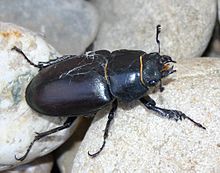
Lucanus cervus, a stag beetle - Family Ochodaeidae Streubel, 1846 (sand-loving scarab beetles)
- Family Hybosoridae Erichson, 1847
- Family Glaphyridae MacLeay, 1819 (bumble bee scarab beetles)
- Family Scarabaeidae Latreille, 1802 (scarab beetles)
- Family †Coprinisphaeridae Genise, 2004 (ichnotaxon)
- Family †Pallichnidae Genise, 2004 (ichnotaxon)
- Superfamily Scarabaeoidea Latreille, 1802
- Infraorder Elateriformia
- Superfamily Scirtoidea Fleming, 1821
- Family Decliniidae Nikitsky, Lawrence, Kirejtshuk and Gratshev, 1994
- Family Eucinetidae Lacordaire, 1857
- Family Clambidae Fischer von Waldheim, 1821
- Family Scirtidae Fleming, 1821
- Family †Elodophthalmidae Kirejtshuk and Azar, 2008
- Family †Mesocinetidae Kirejtshuk and Ponomarenko, 2010
- Superfamily Dascilloidea Guérin-Méneville, 1843 (1834)
- Family Dascillidae Guérin-Méneville, 1843 (1834)
- Family Rhipiceridae Latreille, 1834
- Superfamily Buprestoidea Leach, 1815
- Family Schizopodidae LeConte, 1859
- Family Buprestidae Leach, 1815

Buprestidae
- Superfamily Byrrhoidea Latreille, 1804
- Family Byrrhidae Latreille, 1804
- Family Protelmidae Jeannel, 1950
- Family Elmidae Curtis, 1830
- Family Dryopidae Billberg, 1820 (1817)
- Family Lutrochidae Kasap and Crowson, 1975
- Family Limnichidae Erichson, 1846
- Family Heteroceridae MacLeay, 1825
- Family Psephenidae Lacordaire, 1854
- Family Cneoglossidae Champion, 1897
- Family Ptilodactylidae Laporte, 1836
- Family Podabrocephalidae Pic, 1930
- Family Chelonariidae Blanchard, 1845
- Family Eulichadidae Crowson, 1973
- Family Callirhipidae Emden, 1924
- Superfamily Elateroidea Leach, 1815
- Family Artematopodidae Lacordaire, 1857
- Family Brachypsectridae Horn, 1881
- Family Cantharidae Imhoff, 1856 (1815) (soldier beetles)
- Family Cerophytidae Latreille, 1834
- Family Elateridae Leach, 1815 (click beetles; includes former Drilidae, Omalisidae, and Plastoceridae)

Agrypnus murinus, a click beetle - Family Eucnemidae Eschscholtz, 1829
- Family Lampyridae Rafinesque, 1815 (fireflies)
- Family Lycidae Laporte, 1836
- Family Omethidae LeConte, 1861 (includes former Telegeusidae)
- Family Phengodidae LeConte, 1861
- Family Rhagophthalmidae Olivier, 1907
- Family Sinopyrophoridae Bi, 2018
- Family Throscidae Laporte, 1840 nomen protectum
- Family †Berendtimiridae Winkler, 1987
- Family †Praelateriidae Dolin, 1973
- Superfamily Rhinorhipoidea Lawrence, 1988
- Family Rhinorhipidae Lawrence, 1988
- Superfamily Scirtoidea Fleming, 1821
- Infraorder Bostrichiformia
- Superfamily Derodontoidea LeConte, 1861
- Family Derodontidae LeConte, 1861
- Family Nosodendridae Erichson, 1846
- Family Jacobsoniidae Heller, 1926
- Superfamily Bostrichoidea Latreille, 1802
- Family Dermestidae Latreille, 1804 (carpet beetles)

Anthrenus verbasci, in the Dermestidae - Family Endecatomidae LeConte, 1861
- Family Bostrichidae Latreille, 1802
- Family Ptinidae Latreille, 1802
- Family Dermestidae Latreille, 1804 (carpet beetles)
- Superfamily Derodontoidea LeConte, 1861
- Infraorder Cucujiformia
- Superfamily Lymexyloidea Fleming, 1821
- Family Lymexylidae Fleming, 1821
- Superfamily Cleroidea Latreille, 1802
- Family Phloiophilidae Kiesenwetter, 1863
- Family Trogossitidae Latreille, 1802
- Family Chaetosomatidae Crowson, 1952
- Family Metaxinidae Kolibáč, 2004
- Family Thanerocleridae Chapin, 1924
- Family Cleridae Latreille, 1802 (checkered beetles)
- Family Acanthocnemidae Crowson, 1964
- Family Phycosecidae Crowson, 1952
- Family Prionoceridae Lacordaire, 1857
- Family Mauroniscidae Majer, 1995
- Family Melyridae Leach, 1815 (soft-winged flower beetles)
- Superfamily Cucujoidea Latreille, 1802
- Family †Parandrexidae Kirejtshuk, 1994
- Family †Sinisilvanidae Hong, 2002
- Family Boganiidae Sen Gupta and Crowson, 1966
- Family Byturidae Gistel, 1848
- Family Helotidae Chapuis, 1876
- Family Protocucujidae Crowson, 1954
- Family Sphindidae Jacquelin du Val, 1860
- Family Biphyllidae LeConte, 1861
- Family Erotylidae Latreille, 1802
- Family Monotomidae Laporte, 1840
- Family Hobartiidae Sen Gupta and Crowson, 1966
- Family Cryptophagidae Kirby, 1826
- Family Agapythidae Sen Gupta and Crowson, 1969
- Family Priasilphidae Crowson, 1973
- Family Phloeostichidae Reitter, 1911
- Family Silvanidae Kirby, 1837
- Family Cucujidae Latreille, 1802
- Family Myraboliidae Lawrence and Britton, 1991
- Family Cavognathidae Sen Gupta and Crowson, 1966
- Family Lamingtoniidae Sen Gupta and Crowson, 1969
- Family Passandridae Blanchard, 1845
- Family Phalacridae Leach, 1815
- Family Propalticidae Crowson, 1952
- Family Laemophloeidae Ganglbauer, 1899
- Family Tasmosalpingidae Lawrence and Britton, 1991
- Family Cyclaxyridae Gimmel, Leschen and Ślipiński, 2009
- Family Kateretidae Kirby, 1837
- Family Nitidulidae Latreille, 1802
- Family Smicripidae Horn, 1880
- Family Bothrideridae Erichson, 1845
- Family Cerylonidae Billberg, 1820
- Family Alexiidae Imhoff, 1856
- Family Discolomatidae Horn, 1878
- Family Endomychidae Leach, 1815
- Family Coccinellidae Latreille, 1807 (ladybirds or lady beetles)

Asian multicolored lady beetle, Harmonia axyridis - Family Corylophidae LeConte, 1852
- Family Akalyptoischiidae Lord, Hartley, Lawrence, McHugh, Whiting and Miller, 2010
- Family Latridiidae Erichson, 1842
- Superfamily Tenebrionoidea Latreille, 1802

Tenebrionoidea - Tenebrio molitor - Family Mycetophagidae Leach, 1815
- Family Archeocrypticidae Kaszab, 1964
- Family Pterogeniidae Crowson, 1953
- Family Ciidae Leach, 1819
- Family Tetratomidae Billberg, 1820
- Family Melandryidae Leach, 1815
- Family Mordellidae Latreille, 1802 (tumbling flower beetles)
- Family Ripiphoridae Laporte, 1840
- Family Zopheridae Solier, 1834
- Family Ulodidae Pascoe, 1869
- Family Promecheilidae Lacordaire, 1859
- Family Chalcodryidae Watt, 1974
- Family Trachelostenidae Lacordaire, 1859
- Family Tenebrionidae Latreille, 1802 (darkling beetles)
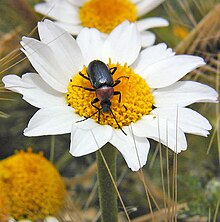
Heliotautus ruficollis, a darkling beetle - Family Prostomidae Thomson, 1859
- Family Synchroidae Lacordaire, 1859
- Family Stenotrachelidae Thomson, 1859
- Family Oedemeridae Latreille, 1810
- Family Meloidae Gyllenhal, 1810 (blister beetles)
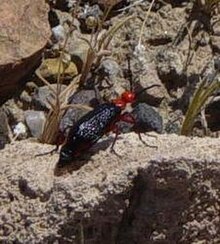
Lytta magister, in the Meloidae - Family Mycteridae Perty, 1840 (palm beetles and flower beetles)
- Family Boridae Thomson, 1859
- Family Trictenotomidae Blanchard, 1845
- Family Pythidae Solier, 1834
- Family Pyrochroidae Latreille, 1806
- Family Salpingidae Leach, 1815
- Family Anthicidae Latreille, 1819
- Family Aderidae Csiki, 1909
- Family Scraptiidae Gistel, 1848
- Clade Phytophaga
- Superfamily Chrysomeloidea Latreille, 1802
- Family Oxypeltidae Lacordaire, 1868
- Family Vesperidae Mulsant, 1839
- Family Disteniidae Thomson, 1861
- Family Cerambycidae Latreille, 1802 (longhorn beetles)
- Family Megalopodidae Latreille, 1802
- Family Orsodacnidae Thomson, 1859
- Family Chrysomelidae Latreille, 1802 (leaf beetles)
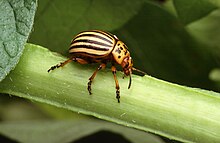
Colorado potato beetle, Leptinotarsa decemlineata, a leaf beetle
- Superfamily Curculionoidea Latreille, 1802
- Family Nemonychidae Bedel, 1882
- Family Anthribidae Billberg, 1820
- Family †Ulyanidae Zherikhin, 1993
- Family Belidae Schönherr, 1826
- Family Caridae Thompson, 1992
- Family Attelabidae Billberg, 1820
- Family Brentidae Billberg, 1820
- Family Brachyceridae Billberg, 1820
- Family Curculionidae Latreille, 1802 (snout beetles, weevils, and bark beetles) [6]
- Superfamily Chrysomeloidea Latreille, 1802
- Superfamily Lymexyloidea Fleming, 1821
- Infraorder Staphyliniformia
- Suborder †Protocoleoptera


















